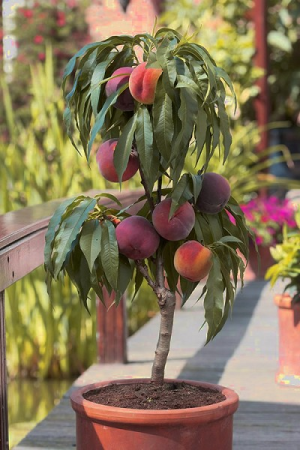Dwarf fruit trees take up a smaller space in the garden or lawn
We seem to like the number seven: there are seven seas, and if you break a mirror, you get seven years of bad luck. So it is no surprise that Snow White had seven dwarfs. The 1937 animated classic “Snow White and the Seven Dwarfs” earned so much money that it paid to build Disney Studios in 1937.
But the most valuable dwarfs to gardeners are dwarf plants. The aptly named Little Oliver daffodil is a cheery yellow with a darker yellow cup and only grows three to four inches tall. The equally fragrant daffodil Tete a Tete stands only a few inches taller, and true to its name (French meaning head to head) it has two blooms on every stem.
Besides dwarf daffodils, fall is also the best time to plant dwarf fruit trees. Most dwarf trees are the result of grafting a named variety of peach, such as Red Haven, onto a dwarf rootstock. The upper branches will all be Red Haven peach, but the roots and trunk will stay short, often under six feet tall.
There are a few dwarf trees that are just naturally dwarf so they do not need to be grafted. These genetic dwarf trees grow on their own roots.
The Bonanza Miniature Peach will only grow five to six feet tall. The delicious Bonanza Dwarf peaches are ready to pick from mid-June though early August. Bonanza Dwarf peaches are freestones, meaning the pits separate easily from the flesh. Like all peaches, this one is self-pollinating. As a bonus, Bonanza Dwarf peaches burst into bloom every spring with breathtakingly beautiful pink flowers. It is hardy in USDA zones 6 through 10, but can be grown farther north with extra winter protection.
As a companion to your Bonanza Dwarf peach you can add the Leprechaun Dwarf Nectarine. Like Bonanza, Leprechaun Dwarf Nectarine only grows five to six feet tall. You can even grow these in large pots. The medium to large nectarines are a brilliant red over yellow. The fruits are sweet, juicy and also freestone. These nectarines ripen in July. The tree is hardy in USDA zones 5 through 8.
Raintree Nursery (www.raintreenursery.com) just introduced Arctic Babe, the first white-fleshed dwarf nectarine. This exceptionally sweet, large fruit grows on a dwarf tree that gets only four to six feet tall. Like the other dwarf trees, Arctic Babe does well grown in a large pot.
For sweet cherries in a dwarf size, plant Compact Stella with its large, deep-red sweet cherries. Compact Stella will stay compact at four to six feet tall.
There are many advantages to growing dwarf fruit trees. Because they are only head high, all of the chores of keeping fruit trees are easier. Not only easier to pick the fruit, but easier to prune, and if needed, you can cover the entire tree with netting to discourage birds from eating the fruits.
Dwarf fruit trees take up a smaller space in the garden or lawn, so they fit into even the tiniest yards and gardens. Because these dwarfs can all grow in large pots, they can be used on patios, balconies and decks where a full-sized tree wouldn't fit.
There is a downside to dwarf fruit trees in that they are usually shorter-lived than their full-size brethren. Unlike full-sized trees, your dwarf fruit trees may need to be staked so they do not get uprooted in strong winds.
So plant dwarf fruit trees and sprinkle some dwarf daffodils underneath, and before long you will be as happy as the singing seven dwarfs. You may be in seventh heaven.




















































